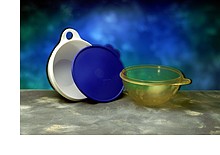|
Tupperware
|
Tupperware catapults its new Thatsa Bowl design into the No.1 best seller in North America
through stereolithography for solid imaging.
"The SLA gives us the ability to predict future marketing trends. We are able to be the first one out the door with what the consumer wants."
- Morison Cousins, Vice President, Design
Tupperware, Inc
|

|
The Challenge
Turning the five designs of Morison Cousins, Tupperware's Vice President, Design, into tangible prototypes in only two weeks presented a formidable challenge to members of Tupperware's prototyping services group. The designs represented iterations of an "ultimate" bowl handle, the critical component of Tupperware's new Thatsa Bowl consumer product. Consumer appeal in look and feel of the handle would make or break the success of the product, so physical models were essential for focus group evaluation.
At the same time, designs must accommodate both molding and ergonomic requirements, plus provide a marriage between traditional model making and contemporary rapid prototyping practices. The bowl portion of the new Thatsa Bowl was already designed and fabricated, requiring an exact fit of the prototype handles to the vacuum formed bowls.
The Results
Within a few months after product introduction, Thatsa Bowl skyrocketed to their top selling product in North America, thanks to the design and production advantages of stereolithography (SL).
Armed with design renderings, the rapid prototyping team quickly translated Cousins' sketches to 3D CAD. The actual SL parts were then built, painted, and used in focus group testing and analysis. Not only did the painted SL parts provide tactile approval from the participants of the focus group, but the winning design was merged directly into a vacuum formed 32-cup styrene bowl without further tooling. This type of design ingenuity through the use of stereolithography is what consistently produces leading market products for Tupperware. In fact, the elegant grace of this bowl's design has won it a spot in the Smithsonian Institute.
Stereolithography provided Tupperware with an overall time reduction in product design of 30-50%. Integration of SL technology into their product development efforts affords the company many additional advantages:
- Accomplish multiple iterations in same the time span once required for a single design
- Produce unique designs incorporating complex shapes
- Receive tactile customer feedback and approval
- Direct use of an SL part with an existing vacuum formed shape
- Use SL parts as patterns to create epoxy tooling
- Reduce prototype generation time up to 50%
The Process
Morison Cousins provided Tupperware's "Design Depot" team with five design suggestions. Recognizing the value of an actual part for evaluation, Bob Wilkie, Tupperware's Prototype Manager requested that plastic prototypes of the designs be built on the company's SLA 250. Successive layer thickness of 0.0025 inches were used to create the complex curves of the three dimensional plastic models during the building process. The handles were spray painted to resemble final product.
A focus group was scheduled to give their approval on the optimum design from the SL models provided. After the winning design was selected, an actual unpainted SL part was merged into a 32-cup vacuum formed styrene bowl for design verification.
Once the final design was zeroed in on, the surface data provided by the Unigraphics CAD/CAM software was used to program their CNC machine to create the intricate design of the handle in the production tool. Tupperware's mold maker was able to verify the accuracy of injection molded parts from the tool with stereolithography part in hand.
The Tools
- Artist renderings provided by Morison Cousins
- Unigraphics CAD software
- SLA 250
Company Profile
Tupperware, based in Kissimmee, Florida is one of the world's largest direct sellers and the world's leading supplier of food storage containers with $1.1 billion in worldwide net sales in 1992. Tupperware's market penetration has made the company's products part of American culture, with Tupperware brand products found in 90% of homes in the U.S. The company is credited with launching the plastics revolution in the early 1950's with its high performance, premium products.
|



